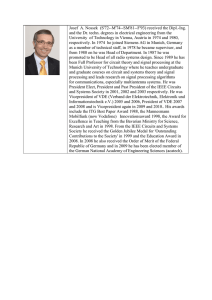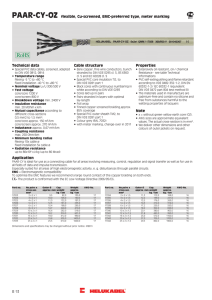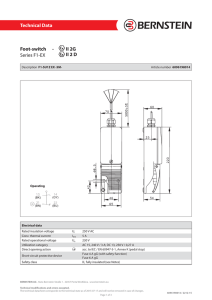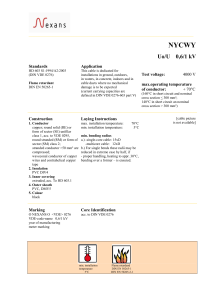The new dimension in insulation monitoring - Bender-UK
advertisement
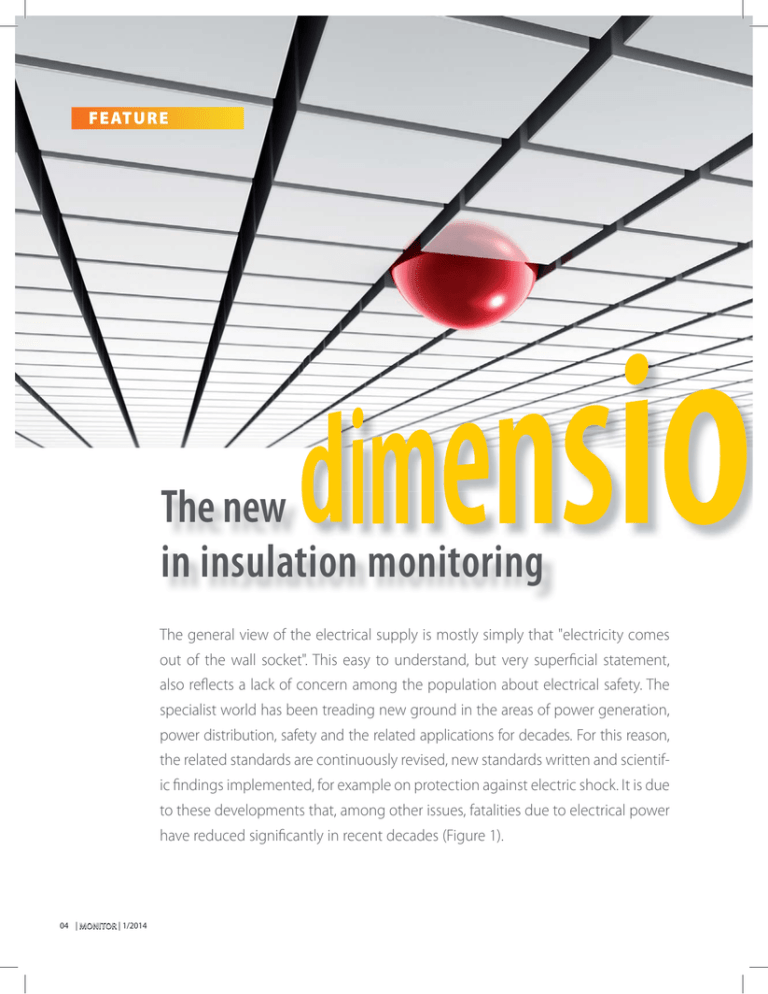
F E ATU R E The new in insulation monitoring The general view of the electrical supply is mostly simply that "electricity comes out of the wall socket". This easy to understand, but very superficial statement, also reflects a lack of concern among the population about electrical safety. The specialist world has been treading new ground in the areas of power generation, power distribution, safety and the related applications for decades. For this reason, the related standards are continuously revised, new standards written and scientific findings implemented, for example on protection against electric shock. It is due to these developments that, among other issues, fatalities due to electrical power have reduced significantly in recent decades (Figure 1). 04 | MONITOR | 1/2014 FIGURE 1: Causes of death statistics, electrical accidents (source: Information from the Institute zur Erforschung elektrischer Unfälle (German institute for research into electrical accidents), BG ETEM) The change in energy policy is one of the most urgent topics for the new German government. For this purpose, approximately 600 experts discussed the future supply of energy at the VDE ENERGY SUMMIT 2013. During a subsequent press conference the VDE Verband der Elektrotechnik Elektronik und Informationstechnik e.V. presented a new document that gives - The research institutes, the manufacturing industries, the trades, the related associations and developers of the standards in the electrical engineering area have contributed to this situation in various ways. An aspect where there is still room for improvement is greater attention to the topic of "standardisation in electrical engineering and protection against electric shock" in the curricula at the universities of applied sciences, for example, as already implemented by at University of Applied Sciences Mittelhessen in Wetzlar. 1/2014 | MONITOR | 05 F E ATU R E a clear overview of the development of the change in energy policy up to 2050. The brochure provides information on new energy distribution systems, "smart grids", energy storage and electric mobility. The current problem areas of electrical energy supply such as energy transport, for instance, are also addressed. Under the leadership of the DKE – German Commission for Electrical, Electronic & Information Technologies of DIN and VDE – comprehensive road maps, in particular in the areas of "smart grids", electric mobility and Industry 4.0, are currently in preparation and undergoing publication in standardisation forums and in this way important implementation groundwork undertaken. However, a key element of all the tasks related to the future is to design the actual power supply systems to be as safe as technically possible. In Germany the DIN VDE 0100 (VDE 0100) "Low-voltage electrical installations" series of standards plays an important role here. Group 400 in this series tackles different aspects of protective measures. Protection against electric shock is defined in part 410. The standard DIN VDE 0100-410 (VDE 0100-410) contains relevant requirements for the installer on safety precautions and protective measures for protection against electric shock, including 06 | MONITOR | 1/2014 basic protection and fault protection for individuals and livestock. The standard also addresses the application and co-ordination of the requirements in relation to external effects. Requirements for the usage of additional protection are stated in specific cases. „ However, a key element of all the tasks related to the future is to design the actual power supply systems to be as safe as technically possible.” The DIN VDE 0100 (VDE 0100) series of standards forms the guidelines for the installation of electrical systems in what is termed the low voltage range for 230 V and 400 V AC systems. During the current and future further development of the series of standards, low-voltage DC systems will also be taken into account, as these will be used more frequently in future. In this internationally harmonised series of standard both the type of earthing of the power supply systems and the selection of the protective and monitoring devices are described. The terms TN, TT and IT system for the types of system became established across Europe some time ago. The abbreviations "RCD" for residual current devices and "IMD" for insulation monitoring device have also become established in the specialist literature. The unearthed IT system is a form of power supply that has seen a significant upturn in recent decades. From the few early applications known in the mining and medical sectors, today there are many applications for this type of system. Unearthed IT systems are essential where particularly high system availability is required and a power failure on the first insulation fault or earth fault is unacceptable. The usage of an IT system is also almost ideal for applications in which DC components are to be expected on the occurrence of an insulation fault. IT systems are excellently suited to today's applications, for instance, in photovoltaics or electric mobility, and are to be found in the following standards for example: • DIN VDE 0100-712 (VDE 0100-712): Low-voltage electrical installations - Part 7-712: Requirements for special installations or locations - Solar photovoltaic (PV) power supply systems. The special requirements in this part are to be applied to electrical installations for PV power supply systems including systems with AC modules. • DIN VDE 0100-722 (VDE 0100-722): Low-voltage electrical installations - Part 7-722: Requirements for special installations or locations - Supply of electric vehicle. This standard contains requirements on the supply of power for electric vehicles. • Draft ETSI EN 301 605 Environmental Engineering (EE); Earthing and bonding of 400 VDC data and telecom (ICT) equipment. This standard is used in computer centres and telecommunications facilities with a 400 V DC supply. Unearthed IT systems are also increasingly used in applications where significant system leakage capacitances are to be expected or where a low earthing resistance cannot be achieved. The prerequisite for the exploitation of the advantage of the protection against failure despite an insulation fault or a direct earth 1/2014 | MONITOR | 07 F E ATU R E fault in unearthed systems is the monitoring of the active conductor in relation to the protective earth conductor using an insulation monitoring device (IMD). This type of monitoring is addressed in the German standard DIN VDE 0100-410 (VDE 0100410): 2007-06 in section 411.6. More detailed information on the selection of insulation monitoring devices is to be found in: • DIN VDE 0100- 530 (VDE 0100-530): 2011-06, Low-voltage electrical installations - Part 530: Selection and erection of electrical equipment – Switchgear and controlgear, section 538.3. The development of international standards is also following the increased usage of insulation monitoring devices (IMDs). The international standard IEC 61557-8 is already available in its 3rd revision and takes into account recent findings in photovoltaics with a new annex on IMDs for photovoltaic applications. The title of this standard is: IEC 61557-8, Electrical safety in low voltage distribution systems up to 1000 V a.c. and 1500 V d.c. - Equipment for testing, measuring or monitoring of protective measures - Insulation monitoring devices for IT systems; and it corresponds to the draft German standard E DIN EN 615578 (E VDE 0413-8): 2013-08, Elektrische Sicherheit in Niederspannungsnetzen bis AC 1000 V und DC 1500 V – Geräte zum Prüfen, Messen oder Überwachen von Schutzmaßnahmen. However, a further important development is to be seen in the standardisation activities at the IEC (International Electrotechnical Commission) – the requirements on the functional safety of IMDs in IT systems. For future applications a standard has been prepared with the German title: DIN EN 61557-15 (VDE 0413-15): Elektrische Sicherheit in Niederspannungsnetzen bis AC 1000 V und DC 1500 V - Geräte zum Prüfen, Messen oder Überwachen von Schutzmaßnahmen - Teil 15: Anforderungen zur Funktionalen Sicherheit von Isolationsüberwachungsgeräten in IT-Systemen und von Einrichtungen zur Isolationsfehlersuche in IT-Systemen. The application area is described as follows: This part of IEC 61557 defines requirements for the realisation of the functional safety of insulation monitoring devices (IMD ) in accordance with IEC 61557-8 and of insulation fault location systems (IFLS ) in accordance with IEC 61557-9 for phase 10 of the lifecycle in accordance with IEC 61508-1. These devices contain safety-related functions for IT systems. IMDs and IFLS are not protective devices, but they are part of the protective measure in IT systems. The functions in IMDs and IFLS, such as the continuous monitoring of the insulation resistance of an unearthed IT system and the localisation of insulation faults in part of the system, can however be considered safety functions that are part of the protective measures in IT systems. This standard can only be applied to IMDs and IFLS that include safety functions with SIL 1 and SIL 2. Higher SILs are not specified in this standard, as they are generally not necessary for IMDs and IFLS in IT systems. Compliance with this standard can be necessary if functional safety is required for IMDs or IFLS in the related application in the IT system. However, the standard does not define that a specific level of functional safety in accordance with this standard is always required for these devices. Dipl.-Ing. Wolfgang Hofheinz Chair of the DKE (DKE German Commission for Electrical, Electronic & Information Technologies of DIN and VDE) 08 | MONITOR | 1/2014



